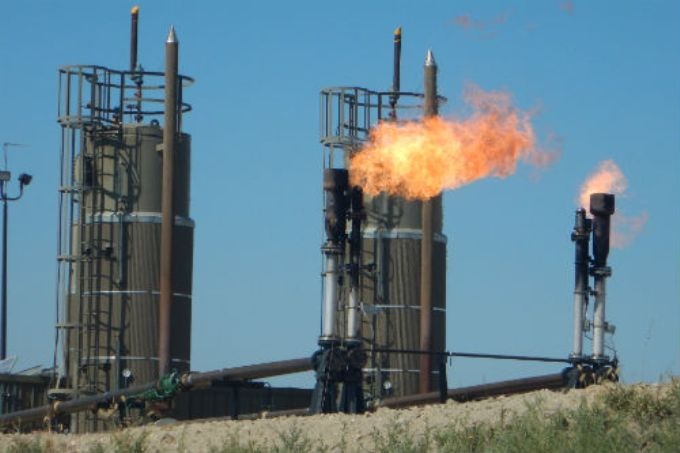Dec 11 2019
American Geophysical Union has found that understanding the factors influencing the amount of methane in the atmosphere is one of the principal challenges in the earth sciences in the next decades due to methane’s highly important role in fulfilling climate warming targets.
 Methane flaring in the Bakken oil field of North Dakota. Image Credit: Rob Jackson, Stanford University.
Methane flaring in the Bakken oil field of North Dakota. Image Credit: Rob Jackson, Stanford University.
The second most significant manmade greenhouse gas is methane. The quick increase of methane levels in the atmosphere than estimated is not well understood. Methane can potentially warm the Earth approximately 30 times more than carbon dioxide (CO2) over a century timescale.
It is vital to ensure reductions in global methane emissions to fulfill global climate warming targets. The aim of the 2015 Paris Agreement is to maintain the increase in global average temperature well below 2 °C of pre-industrial levels in 2100.
Success depends on individual countries bringing down their greenhouse gas emission via Nationally Determined Contributions, which will be assessed every five years as part of a global stock-taking.
A new study recently reported by climate researchers from the University of Bristol describes the new technologies and scientific advances required to monitor the progress in emission reductions.
About half of the methane in the atmosphere is emitted from natural sources, which include geological seeps and wetlands.
The remaining portion is emitted from fossil fuel use, agriculture, and other human activities. Since methane is such a strong absorber of radiation in the atmosphere and decays in the atmosphere rapidly than CO2, expected atmospheric concentration pathways that fulfill the Paris Agreement try to lower anthropogenic methane emissions by nearly half of current levels.
The “budget” of methane in the atmosphere is the total of the different individual sources and “sinks” (the elimination of methane from the atmosphere) that change the total amount of methane in the atmosphere.
There are major challenges in our ability to quantify this budget, and these challenges make it difficult to assess whether the emission reductions pledged for the Paris Agreement are actually occurring.
Dr Anita Ganesan, Study Lead Author, School of Geographical Sciences, University of Bristol
The new study emphasizes new interesting methods being used to evaluate methane in the environment, explains the present limitations in the major fields of methane science, and suggests advances that, over the next 10 years, would greatly improve the potential of understanding the mechanisms leading to changes in atmospheric methane.
A few of these new technologies have the potential to measure rarer isotopic variants of methane, offering the new capability to identify the sources of emissions, satellites to map concentrations of methane universally with exceptional detail, and systems for monitoring potential “feedback” emissions from permafrost.
The interpretation of these new measurements by advanced model simulations of the atmosphere will enable more precise quantification of emissions by making use of measurements in the atmosphere.
The research also explains the main advances required for countries to better record their methane emissions, for instance, by monitoring the composition of waste sent to landfills, or by monitoring emissions from leaks in the oil and gas industry.
The three key features of methane science covered are atmospheric measurements of methane and its isotopic variations, the quantification of the different components of the methane budget from atmospheric measurements, and models that mimic the processes behind methane emissions.
Developments in these three areas will jointly lead to more precise quantification of methane emissions, which is a key step toward understanding whether the aim of the Paris Agreement is met.
We can’t explain with very much confidence the factors that have resulted in large variations in the atmosphere in the past few decades, and with that level of present uncertainty—knowing how to control these concentrations to be in line with climate targets is an even bigger challenge.
Dr Matt Rigby, Study Co-Author, School of Chemistry, University of Bristol
Dr Ganesan added, “Since the Paris Agreement, there has unfortunately been a large divergence between some of the planned concentration pathways that would meet Paris targets and actual methane concentrations in the atmosphere.”
The impact is that revised pathways now call for cuts in methane concentrations to occur later and by a much larger amount. Each year that reductions are delayed implies a greater reduction for the future. Until we understand what controls the variations in atmospheric concentrations of methane, we risk falling farther behind.
Dr Anita Ganesan, Study Lead Author, School of Geographical Sciences, University of Bristol
Source: https://www.bristol.ac.uk/